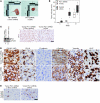Deregulation of the Pit-1 transcription factor in human breast cancer cells promotes tumor growth and metastasis
- PMID: 21060149
- PMCID: PMC2993584
- DOI: 10.1172/JCI42015
Deregulation of the Pit-1 transcription factor in human breast cancer cells promotes tumor growth and metastasis
Abstract
The Pit-1 transcription factor (also know as POU1F1) plays a critical role in cell differentiation during organogenesis of the anterior pituitary in mammals and is a transcriptional activator for pituitary gene transcription. Increased expression of Pit-1 has been reported in human tumorigenic breast cells. Here, we found that Pit-1 overexpression or knockdown in human breast cancer cell lines induced profound phenotypic changes in the expression of proteins involved in cell proliferation, apoptosis, and invasion. Some of these protumorigenic effects of Pit-1 were mediated by upregulation of Snai1, an inductor of the epithelial-mesenchymal transition. In immunodeficient mice, Pit-1 overexpression induced tumoral growth and promoted metastasis in lung. In patients with invasive ductal carcinoma of the breast and node-positive tumor, high expression of Pit-1 was significantly correlated with Snai1 positivity. Notably, in these patients elevated expression of Pit-1 was significantly and independently associated with the occurrence of distant metastasis. These findings suggest that Pit-1 could help to make a more accurate prognosis in patients with node-positive breast cancer and may represent a new therapeutic target.
Figures









Similar articles
-
Cancer progression by breast tumors with Pit-1-overexpression is blocked by inhibition of metalloproteinase (MMP)-13.Breast Cancer Res. 2014 Dec 20;16(6):505. doi: 10.1186/s13058-014-0505-8. Breast Cancer Res. 2014. PMID: 25527274 Free PMC article.
-
The Pit-1/Pou1f1 transcription factor regulates and correlates with prolactin expression in human breast cell lines and tumors.Endocr Relat Cancer. 2010 Jan 29;17(1):73-85. doi: 10.1677/ERC-09-0100. Print 2010 Mar. Endocr Relat Cancer. 2010. PMID: 19808898 Free PMC article.
-
Role of MRE11 in cell proliferation, tumor invasion, and DNA repair in breast cancer.J Natl Cancer Inst. 2012 Oct 3;104(19):1485-502. doi: 10.1093/jnci/djs355. Epub 2012 Aug 22. J Natl Cancer Inst. 2012. PMID: 22914783
-
Breast cancer metastasis to liver and lung is facilitated by Pit-1-CXCL12-CXCR4 axis.Oncogene. 2018 Mar;37(11):1430-1444. doi: 10.1038/s41388-017-0036-8. Epub 2018 Jan 11. Oncogene. 2018. PMID: 29321662
-
Vitamin D, Pit-1, GH, and PRL: possible roles in breast cancer development.Curr Med Chem. 2007;14(29):3051-8. doi: 10.2174/092986707782793943. Curr Med Chem. 2007. PMID: 18220741 Review.
Cited by
-
CXCL12-CXCR4/CXCR7 Axis in Cancer: from Mechanisms to Clinical Applications.Int J Biol Sci. 2023 Jun 26;19(11):3341-3359. doi: 10.7150/ijbs.82317. eCollection 2023. Int J Biol Sci. 2023. PMID: 37497001 Free PMC article. Review.
-
Potential therapeutic effect of the secretome from human uterine cervical stem cells against both cancer and stromal cells compared with adipose tissue stem cells.Oncotarget. 2014 Nov 15;5(21):10692-708. doi: 10.18632/oncotarget.2530. Oncotarget. 2014. PMID: 25296979 Free PMC article.
-
Research resource: A genome-wide study identifies potential new target genes for POU1F1.Mol Endocrinol. 2012 Aug;26(8):1455-63. doi: 10.1210/me.2011-1308. Epub 2012 May 25. Mol Endocrinol. 2012. PMID: 22638072 Free PMC article.
-
Genetic mechanism of β-alanine metabolic pathway affecting colorectal cancer prognosis.BMC Gastroenterol. 2025 Jul 1;25(1):480. doi: 10.1186/s12876-025-04051-2. BMC Gastroenterol. 2025. PMID: 40597677 Free PMC article.
-
POU1F1 transcription factor induces metabolic reprogramming and breast cancer progression via LDHA regulation.Oncogene. 2021 Apr;40(15):2725-2740. doi: 10.1038/s41388-021-01740-6. Epub 2021 Mar 13. Oncogene. 2021. PMID: 33714987 Free PMC article.
References
-
- Thiery JP. Epithelial-mesenchymal transitions in tumour progression. Nat Rev Cancer. 2002;2(6):442–454. - PubMed
Publication types
MeSH terms
Substances
LinkOut - more resources
Full Text Sources
Other Literature Sources
Medical
Research Materials

